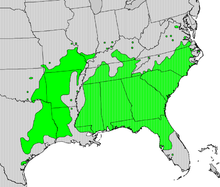| Vaccinium arboreum | |
|---|---|

| |
| Conservation status | |
 Least Concern (IUCN 3.1) | |
| Scientific classification | |
| Kingdom: | Plantae |
| Clade: | Tracheophytes |
| Clade: | Angiosperms |
| Clade: | Eudicots |
| Clade: | Asterids |
| Order: | Ericales |
| Family: | Ericaceae |
| Genus: | Vaccinium |
| Species: | V. arboreum |
| Binomial name | |
| Vaccinium arboreum Marshall 1785 | |

| |
| Synonyms | |
| |
Vaccinium arboreum (sparkleberry or farkleberry) is a species of Vaccinium native to the southeastern and south-central United States, from southern Virginia west to southeastern Nebraska, south to Florida and eastern Texas, and north to Illinois.
Description
Vaccinium arboreum is a shrub (rarely a small tree) growing to 3–5 m (7.5-12.5 feet) rarely 9 m) (22.5 feet) tall, with a diameter at breast height of up to 35 cm (14 inches). The leaves are evergreen in the south of the range, but deciduous further north where winters are colder; they are oval-elliptic with an acute apex, 3–7 cm long and 2–4 cm broad, with a smooth or very finely toothed margin. Sparkleberry grows on sand dunes, hammocks, dry hillsides, meadows, and in rocky woods. It also grows on a variety of moist sites such as wet bottomlands and along creek banks.
The flowers are white, bell-shaped, and 3–4 mm (0.12-0.16 inches) in diameter with a five-lobed corolla, produced in racemes up to 5 cm (2 inches) long. The fruit is a round dry berry about 6 mm (0.24 inches) in diameter, green at first, black when ripe, edible but bitter and tough. They are eaten by various wildlife.
Because of its relative hardiness in comparison to other Vaccinium species, Vaccinium arboreum has been investigated as a potential rootstock for expanding the range of blueberry cultivation to less acidic soils(PH>6.0) and reducing the severity of bacterial leaf scorch Cytology is 2n = 24.
References
- IUCN SSC Global Tree Specialist Group.; Botanic Gardens Conservation International; et al. (BGCI) (2020). "Vaccinium arboreum". IUCN Red List of Threatened Species. 2020: e.T152906341A152906343. doi:10.2305/IUCN.UK.2020-1.RLTS.T152906341A152906343.en. Retrieved 19 November 2021.
- The Plant List, Vaccinium arboreum var. glaucescens (Greene) Sarg.
- Tropicos, Vaccinium arboreum Marshall
- USDA; Native Distribution - V. arboreum . accessed 11.10.2010
- Biota of North America Program 2014 county distribution map
- ^ Flora of North America, Vaccinium arboreum Marshall, 1785. Farkleberry
- Little, Elbert L. (1980). The Audubon Society Field Guide to North American Trees: Eastern Region. New York: Knopf. p. 629. ISBN 0-394-50760-6.
- Darnell, Rebecca L.; Williamson, Jeffrey G.; Bayo, Deanna C.; Harmon, Philip F. (2020-01-01). "Impacts of Vaccinium arboreum Rootstocks on Vegetative Growth and Yield in Two Southern Highbush Blueberry Cultivars". HortScience. 55 (1): 40–45. doi:10.21273/HORTSCI14585-19. ISSN 0018-5345. S2CID 213728124.
- Redpath, Lauren E.; Aryal, Rishi; Lynch, Nathan; Spencer, Jessica A.; Hulse-Kemp, Amanda M.; Ballington, James R.; Green, Jaimie; Bassil, Nahla; Hummer, Kim; Ranney, Thomas; Ashrafi, Hamid (2022). "Nuclear DNA contents and ploidy levels of North American Vaccinium species and interspecific hybrids". Scientia Horticulturae. 297. Elsevier BV: 110955. doi:10.1016/j.scienta.2022.110955. ISSN 0304-4238.
External links
- "Vaccinium arboreum". Germplasm Resources Information Network. Agricultural Research Service, United States Department of Agriculture.
- Missouri Plants: Vaccinium arboreum
- Virginia Tech Dendrology: Vaccinium arboreum
- United States Department of Agriculture Plants Profile of Vaccinium arboreum
| Taxon identifiers | |
|---|---|
| Vaccinium arboreum |
|
This Ericaceae article is a stub. You can help Misplaced Pages by expanding it. |